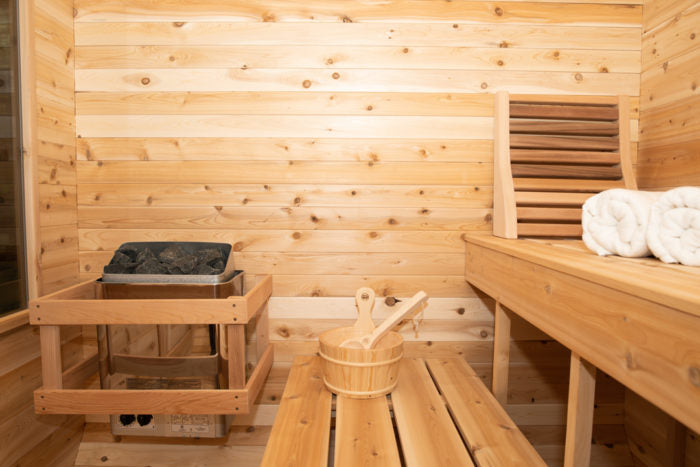Not known Details About Traditional Sauna
Not known Details About Traditional Sauna
Blog Article
The 7-Second Trick For Traditional Sauna
Table of Contents5 Simple Techniques For Traditional SaunaThe Greatest Guide To Traditional SaunaTraditional Sauna Fundamentals ExplainedTraditional Sauna Fundamentals Explained
Many of the weight shed in a sauna is water loss and is re-gained upon rehydrating. Without an uncertainty sauna can be a crucial component of a healthy and balanced weight loss program. To look at the differences in between traditional and IR saunas, I will separate these right into verifiable, theoretical, and made differences.Therefore, the hottest point in the saunawhich is at the ceiling straight over the sauna heateris usually in between 185 and 190 F. Traditional Sauna. Claims that a conventional sauna goes beyond 200 F is just not real and not relevant for electric saunas sold in the US. The temperature level for a far-infrared sauna is typically established in between 120 and 140 F; nevertheless, unlike the typical sauna, the objective in and IR space is not to attain a high temperature
Since of this, the temperature level difference is virtually unnecessary, because profuse sweating leads to both sauna kinds, but the technique of warming the body is various. In an IR sauna the bather will certainly feel hot and will certainly sweat a lot, but at much reduced temperatures. Therefore, if the goal is to spend longer periods of time in the sauna, the IR sauna is a great choice.

Some Ideas on Traditional Sauna You Should Know
When the heat is accomplished, the aspects cycle on and off to preserve the high temperature. A lot of conventional sauna individuals enjoy pouring water over the rocks to create steam to elevate sauna humidity degrees. The benefits of pouring water over the rocks include: making the room more comfortable, moistening the nasal passages, and allowing the usage of aromatherapy by blending essential oils with the water.
In a far-infrared sauna, the warm front permeate the body to efficiently heat the body and raise the body core temperature level. To attain this boosted temperature, Far-infrared emitters create infrared power which is close to the very same wavelength as that which the body normally emitsoften described as the "Vital Range" of 7 to 14 microns), so the energy is well received by the body.
When the energy gets in the body, it triggers the body temperature level to enhance and ultimately leads to sweat. In an infrared sauna it is essential for the emitters/heaters to continue to be on virtually constantly. Because there is no mass of rocks to maintain warmth, the sauna will cool if the emitters shut down.
As pointed out over, the sauna bather in an infrared space desires to position himself before operating emitters to get maximum gain from the heat. The heating time for the 2 spaces can be very various, relying on just how the spaces are used. For a standard sauna, a bather needs to allow 30-40 mins for the space to accomplish a desired temperature level and to correctly pre-heat the rocks.
Some Known Incorrect Statements About Traditional Sauna
A well built sauna will commonly attain read more a temperature level of 150-160 F in about 30-40 mins. For hotter temperatures, the area may need to heat for a longer duration.
To some, 15 minutes was "thrown away" while the infrared energy heated up the timber panels as opposed to heating up a body, while others find a pre-heated space to be much more comfortable and believe an elevated starting temperature is needed to begin perspiring. The length of advised use for each and every room is approximately the very same (10-15 minutes per session); nevertheless, because of the lower air temperatures and the capability to feel the effects of infrared heat faster than a conventional sauna, it is not unusual for an individual to spend a total of 20-30 mins in an infrared sauna.
Traditional saunas tend to be bigger (thus utilize more electricity) than infrared saunas, although traditional saunas are definitely readily available in one and 2 person sizes as well. For a two-person conventional sauna, 5x6 or 5x7 dimension is most preferred. The leading bench can conveniently seat 2 or three individuals and is also long sufficient to relax during the sauna session.


The ordinary cost per kWH of electricity in the united state is about $0.11, so a 4.5 kW heating unit will certainly set you back approximately $.50 to run for one hour, if the heating system runs constantly for one hour. Commonly a sauna heating unit will certainly compete 75% of the very first hour and 50% of succeeding hours on because the elements cycle once the established temperature is attained.
Traditional Sauna for Beginners
A two individual far-infrared area is usually literally navigate to this site smaller sized than a standard sauna, typically about 4' x 4' or smaller. The IR furnace is normally 1.5-1.7 kW using a 120 volt 15 amp plug-in solution. Considering that the area can be made use of sooner than a sauna room, we will certainly assume the room is made use of for to of an hour including warm up time.
Lastly, there is a rarely talked about difference in the click reference social experience between the two areas. While our society has lost some of the social advantage of the traditional sauna experience, it can be extremely socially gratifying. From household time in the sauna, to heart-felt discussions with better halves, to sauna partiesthe typical sauna experience can bring about intimate socializing.
Many higher end infrared spaces include tinted light therapy, noise systems and full-glass fronts.
Report this page